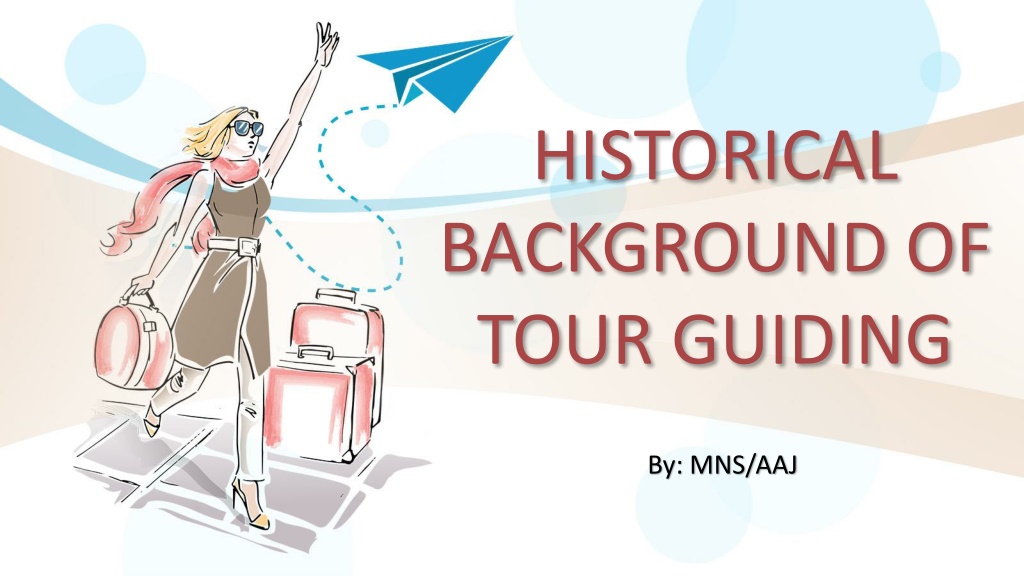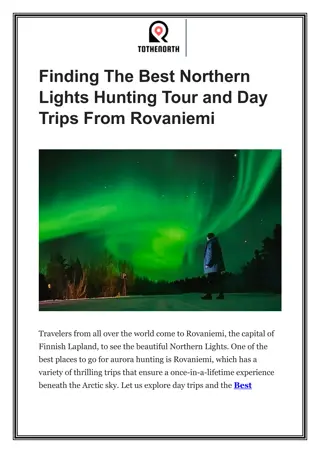Evolution of Tour Guiding Through History
Tour guiding, one of the world's oldest professions, has evolved significantly from the Ancient Empire to the Middle Ages, Renaissance, and the Grand Tour era. Guides in different periods played diverse roles such as leaders, protectors, and educators, shaping the travel experience for generations. The expectations and standards for guides have transformed over time, reflecting the changing dynamics of travel and tourism.
Download Presentation

Please find below an Image/Link to download the presentation.
The content on the website is provided AS IS for your information and personal use only. It may not be sold, licensed, or shared on other websites without obtaining consent from the author.If you encounter any issues during the download, it is possible that the publisher has removed the file from their server.
You are allowed to download the files provided on this website for personal or commercial use, subject to the condition that they are used lawfully. All files are the property of their respective owners.
The content on the website is provided AS IS for your information and personal use only. It may not be sold, licensed, or shared on other websites without obtaining consent from the author.
E N D
Presentation Transcript
HISTORICAL BACKGROUND OF TOUR GUIDING By: MNS/AAJ
HISTORICAL BACKGROUND OF TOUR GUIDING Tour Guiding is one of the world's oldest profession, it began revolutionarily from the Ancient Empire, the Middle Ages, the Renaissance and the Grand Tour with the modern tour guide. evolutionarily and not
Tour Guiding in the Ancient Empire The Ancient Empire travel developed from 3000 BC to 500 A.D. Guides are named periegetai (leaders around) (explainer) in the Greek language. The tasks of Proxemos were to help fellow people travel abroad. or exegetai
Herodotus The first travel writer was able to provide numerous references to guides. Negative in particular of guides who were inclined to recite wit great opportunity, dates, dialogues and other information about who lived hundreds of years ago.
Tour Guiding in the Middle Ages The period between Rome's fall and the Renaissance is known as the Dark Ages (500 A.D. and 1508 A.D.). Rome's fall has led to a decline in trade and the economy in general and a decline in travel desire. Guides positions are pathfinders, protectors, security escorts and even bridges during this era are stressed to ensure safe passage. A guide was paid a large fee, according to Casson, a historian, because he not only led the way but also created safe behavior for the travelers.
Tour Guiding in the Renaissance and Grand Tour Tour Guiding during the Renaissance and the tour guide's Grand Tour image was greatly enhanced during the Renaissance. It was during this period that the Grand Tour, a prescribed route from England through France, Germany, Australia, Switzerland to Italy, was traveled by young men of the upper classes from Britain.
Grand Tourist was expected to return from his travel with a broadened mind, a good command of foreign languages, self-reliance, a highly dev. taste and graceful manner. Cicerone was expected to be articulate, multi-lingual and well-versed in many subjects including history, literature, architecture and current events. Vicesimus Knox (an expert on education) the ideal tutor was a grave, respectable man of mature age who would watch over the morals and religion of his pupil.
For this reason they hired a vetturino a driver of the Italian for four- wheeled carriages called veturra, was able to find things with highway robbers to ensure the safe conduct of the tourist. Francis Bacon is a British writer remarked on the need for a personal guide/courier when traveling specially one who was a linguist and who knows the right people to meet and the proper things.
Tour guiding in the Modern Age During the 18th and 19th century travelers to and within the New World were explorers rather than pleasure travelers. The first travelers were ordinary often indigent explorers who traveled a lot to find a new way of life. Charles Dickens, Francis Trollope, and Alexis de Tocqueville (The 3 well known European writers who visited the New World in the 19th century) traveled widely and wrote comprehensive accounts of their travels but rarely mentioned guides.
The Tour Guide in Europe No evidence exist of organized training for guides before the 12th century other than the company training given by the Thomas Cook Travel Agency. England was on of the 1st countries to regulate and train guides. The competitive, aggressive approach by tour guides towards visitors and with each other prompted the London Country Council and the Regent Street Polytechnic to open a training course for guides in 1936 to 1939. European guides have been widely regarded as having the most advance training and the highest guiding standards in the world.
FOUNDED THE MODERN TOURIST INDUSTRY - THOMAS COOK Thomas Cook ( Nov. 22,1808 - July 18, 1892) of Melbourne Derbyshire, England founded the travel agency. Thomas Cook & Son (popularly nicknamed Cook s Tours) that became Thomas Cook AG before eventually becoming Thomas Cook Group in 2007.
In 1805 he offfered the Grand Circular Tours of Europe In 1866, he introduced the Hotel Coupon. From 1847 to 1922 , Thomas Cook & Sons published Tourists handbooks for the differenct countries of Europe.
Israel guides is the worlds best trained, most highly respected and best paid guides. After the 2nd World War the London Country Council reestablished its guide training program at Regent Street Polytechnic in 1949 and the ApprovedGuides which accredited guides with a badge and certificate. Guiding training and regulation in most European countries served as model for the world where, until recently, few advancement in the professional status have been achieved.
THANK YOU!!! By: MNS/AAJ

























